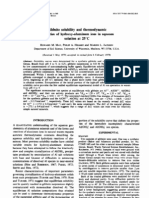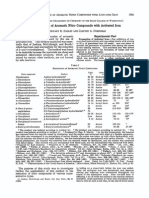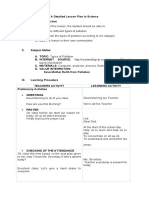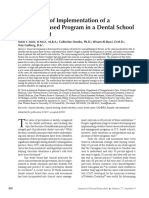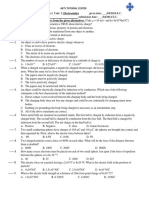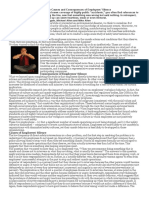Biokimia
Biokimia
Uploaded by
Lilis TuslinahCopyright:
Available Formats
Biokimia
Biokimia
Uploaded by
Lilis TuslinahCopyright
Available Formats
Share this document
Did you find this document useful?
Is this content inappropriate?
Copyright:
Available Formats
Biokimia
Biokimia
Uploaded by
Lilis TuslinahCopyright:
Available Formats
Iournal of
Agricultural
MAY 1993
andFood
VOLUME 41, NUMBER 5
Chemistrv
0 Copyright 1993 by the American Chemical Society
SHORT COMMUNICATIONS
Benzene Production from Decarboxylation of Benzoic Acid in the
Presence of Ascorbic Acid and a Transition-Metal Catalyst
INTRODUCTION specific indicator of hydroxylradical (Winston et al., 1983).
Ascorbic acid (vitamin C) is a natural component of Although the three isomeric hydroxybenzoates have also
been measured as products of hydroxyl radical attack on
many foods and is often added to foods and beverages as benzoate (Loeble et al., 1951; Armstrong et al., 1960), we
a vitamin supplement or fortifier and promoted as an have not found any report of benzene production by this
antioxidant. Transition metals, e.g., Cu(I1) and Fe(III), reaction.
can catalyze the one-electron reduction of 02 by ascorbic
acid to produce the superoxide anion radical, which The present study shows that hydroxyl radical, gener-
undergoes spontaneous disproportionation to produce ated by the metal-catalyzed reduction of 02 and H202 by
hydrogen peroxide. Subsequent metal-catalyzed reduction ascorbic acid, can attack benzoic acid to produce benzene
of HzOz by ascorbic acid can generate the hydroxyl radical under conditions prevalent in many foods and beverages.
(Halliwell and Gutteridge, 1981): Since benzene has been shown to be carcinogenic(Maltoni
-
and Scarnato, 1979),ita potential formation in foods during
processing and storage should be of some concern.
Cu2++ H,Asc Cu+ + HAsc' (1)
+
c u + 0, - cu2++ 0,- (2)
MATERIALS AND METHODS
Desferal mesylate (desferioxamine) was a gift from Ciba
Pharmaceutical Co. Ascorbic acid stock solutions were prepared
20,- + 2H+ - 0, + H,O, (3)
fresh daily in 0.1 M HCl to stifle autoxidation. Hydrogen peroxide
stock solutionswere standardized colorimetricallywith saturated
Cu+ + H,O, - Cu2++ OH- + OH' (4)
TiOSO4 solution in 2 M &So4 (c = 717 M-l cm-l at 410 nm) (Ellis
and Sykes, 1973).
High-PerformanceLiquid Chromatography. The HPLC
system consistedof a Knauer 64 pump, a Rheodyne 7125injection
Sodium benzoate has been widely used as a food valve with 20-pL sample loop, and a Knauer variable-wavelength
UV detector operating at 204 nm with the response recorded on
preservative for many years and is generally recognized as a Kipp and Zonen BD41 strip chart recorder. The analytical
safe (GRAS). The optimum antimicrobial activity occurs column was a 100 X 4.6 mm Spheri-5reversed-phase Cs cartridge
in the pH range 2.5-4.0, indicating benzoic acid (pK, = with a 30 X 4.6 mm guard cartridge of the same packing material
4.2) is the active form of this antimicrobial agent, making (Applied Bioscience, Inc.). The mobile phase was 25% aqueous
it most suitable for foods and beverageswhich are naturally acetonitrile (spectral quality, Baker Chemical Co.) filtered
acidic (Chichester and Tanner, 1968). The sodium salt is through 0.2-pm membrane filters prior to use each day and was
preferred because of ita much higher solubility in aqueous pumped at a flow rate of 3.0 mL/min.
media. It is generally permitted in beverages a t a level of A 2.0 p M aqueous benzene standard solution was stored
less than 0.1% (ca. 7 mM), although higher levels are refrigerated in a capped container. Dilutions of this standard in
permitted for some foods. water were used as the working standards for HPLC analysis.
Benzene was well separated from other componentsin the reaction
Mathew and Sangster (1965) have shown that sodium mixtures under these conditions and was quantitated by com-
benzoate is decarboxylated by hydroxyl radical attack. parison of peak height with the standard solutions.
Sagone et al. (1980) used 14C-labeledbenzoate decarbox- Reaction Conditions. Reaction mixtures were placed in a
ylation to show hydroxyl radical generation by phagocytic constant-temperature bath at 25 OC for 15 min, at which time
leukocytes. Alkoxy1 radicals do not decarboxylate ben- an aliquot was removed and injected into the HPLC system for
zoate, suggesting benzoate decarboxylation is a relatively analysis. All experimentalconditionswere prepared and analyzed
0021-0581I931I44l-O693%04.00/0 0 1993 American Chemlcal Soclety
694 J. Agrlc. Food Chem., Vol. 41, No. 5, 1993 Short Communlcatlons
Table I. Effect of Metal Ions and Ligands on Benzene
Production from Benzoic Acid
addition [benzene],nM
none 6.7 f 1.9
0.1 mM desferal NDb
0.05 mM CuSO4 + 0.1 mM desferal 23.3 f 1.7
0.25 mM CuSO4 + 0.1 mM desferal 27.0 f 1.1
1.0 mM CuSO4 + 0.1 MM desferal 37.3 f 3.1
Y J 2.5 mM CuSO4 + 0.1 mM desferal 29.6 f 3.4
OO 5 Io rb jo
[Ascorbate] mM
is 39
4.0mM CuSO4 + 0.1 mM desferal 29.3 f 0.6
0.05 mM FeS04 21.6 f 0.5
Figure 1. Dependence of benzene production on ascorbic acid 0.25 mM FeS04 13.2 f 1.9
concentration. Reaction conditions were as in Table I, with 0.25 1.0 mM FeS04 11.9 k 0.6
mM CuS04 and varying ascorbic acid concentrations. 0.25 mM FeS04 + 0.25 mM EDTA 17.6 f 0.3
Each reaction mixture contained 50 mM sodium phosphate
P
E39
"1 buffer,pH 3.0,6.25 mMsodium benzoate,8.0 mM ascorbic acid, 10.5
mM hydrogen peroxide,and the additionsindicated in atotal volume
of 2.0 mL. Reaction mixtures were incubated at 25 "C in sealed vials
and aliquota removed at 15 min for analysis of benzene. * ND, none
detected.
[Hydrogen Peroxldr] (mM)
Figure 2. Dependence of benzene production on hydrogen
peroxide concentration. Reaction conditions were as in Table I,
with 0.25 mM CuS04 and varying H202 concentrations.
0 2 4 2, 5 , J
in triplicate. Buffers for the pH dependence study contained 50 ,
3
,
35
,
1
,
45
,
5 55 5
mMphosphoric acid and 50 mM acetic acid (combined), and pH PH
was adjusted with NaOH. NaC104 was added to buffers to give Figure 3. Dependence of benzene production on pH of the
afinalionicstrengthofO.lOM,exceptatpH7.0the ionicstrength solution. Buffer solutions were prepared as described in the text.
was 0.14 M without added NaC104. Reaction conditions were as in Table I, with 0.25 mM CuSO4 and
GC/MS Analysis of Benzene in Headspace. The reaction varying buffer solutions.
mixture was heated to 45 "C, and 500 rL of headspace gas from
the reaction vial was analyzed on a Hewlett-Packard (5890/5971, duced in the absence of H202 when the reaction mixture
Series 11) gas chromatograph/mass spectrometer. A 40 nM was heated to 50 "C for 3 h (25.0 i 1.4 nM benzene
benzene standard in water was used as an external standard for produced, with 8 mM ascorbic acid, 6.2 mM sodium
comparison of retention time and mass spectrum of benzene in benzoate, and 0.25 mM CuSO4 in 50 mM phosphate buffer,
the reaction mixture. pH 3.0). Hydroxyl radical could be formed under these
RESULTS AND DISCUSSION conditions by the sequential reduction of atmospheric O2
present in solutions, as shown in eqs 1-4.
Quantitation of Benzene. The chromatographic Dependence of the Reaction on Transition-Metal
system gave a linear response for benzene standards over Catalyst. Benzene production was optimum at 1.0 mM
a concentration range of 0-100 nM (r2 > 0.981, with a CuSO4 concentration (Table I); higher concentrations of
retention time of approximately 8 min. The lower limit this metal ion resulted in a small decrease in benzene
for detection was approximately 1nM. A time-dependent production. When CuSO4 was omitted from the reaction
study of a typical reaction mixture showed an increase in mixture, there was a significant amount of benzene
benzene production up to ca. 10 min, with no further produced (6.7 f 1.9 nM), which could be completely
change in benzene concentration up to 40 min. Conse- suppressed by addition of 0.1 m M desferioxamine,an iron
quently, all subsequent reaction mixtures were analyzed chelator that suppresses iron-catalyzed production of
for benzene at 15 min after mixing (unless indicated hydroxyl radical by trace amounts of iron in distilled water
otherwise). and buffer salts (Buettner, 1986).
Dependence of the Reaction on Ascorbic Acid and Addition of 0.05 mM FeS04 to the reaction mixture, in
Hydrogen Peroxide. Benzene production increased with the absence of added CuSO4, gave optimum benzene
increasing ascorbic acid concentration at low ascorbic acid production; higher concentrations of FeS04 resulted in
concentrations but decreased with increasing amounts of suppressionof benzene production. These results suggest
ascorbic acid when its concentration exceeded that of these metal ions are necessary to catalyze hydroxyl radical
benzoic acid (Figure 1). This dependence on ascorbic acid production but at higher concentrationsmay interfere with
concentration indicates hydroxyl radical production is benzene production, possibly by catalyzing reactions in
dependent on the concentration of ascorbic acid, but the the free-radicalchain mechanism that do not yield benzene.
ascorbic acid competes with benzoic acid as a scavenger When an equimolar amount of EDTA was added with
of the hydroxyl radical at higher concentrations. 0.25 mM FeS04, there was a small increase in benzene
Benzene production increased linearly with H202 con- production relative to addition of iron without EDTA.
centration until the concentration of H202 exceeded the pH Demndence of the Reaction. The benzene yield
ascorbic acid concentration, reflecting a change in the was measured for this reaction over the pH range 2-7. The
limitingreagent (Figure 2). Under the standard conditions maximum amount of benzene was produced at pH 2, with
(25 OC and 15-min reaction time), there was no benzene a sharp drop in benzene production from pH 3 to pH 5
detected when either ascorbic acid or H202 was omitted (Figure 31, and benzene was not detectable in reaction
from the reaction mixture. However, benzene was pro- mixtures at pH 7. These results indicate that hydroxyl
Short Communications J. Agric. Food Chem., VOl. 41, No. 5, lQQ3 685
radical attack on benzoic acid may yield benzene, but Ellis, J. D.; Sykes, A. G. Kinetic Studies on the Vanadium(I1)-
attack on the benzoate anion apparently yields other Titanium(1V) and Titanium(II1)-Vanadium(1V) Redox Re-
products, such as hydroxybenzoates, phenol, or biphenyl actions in Aqueous Solutions. J . Chem. SOC.,Dalton Tram.
(Loeble et al., 1951; Armstrong et al., 1960; Sugimore et 1973,537-543.
al., 1960; Sakumoto et al., 1961). Halliwell, B.; Gutteridge, J. M. C. The Importance of Free
Positive Identification of Benzene in Reaction Radicals and Catalytic Metal Ions in Human Disease. Mol.
Mixtures by W/MS Analysis. Complete reaction Aspects Med. 1985,8, 89-193.
mixtures were placed in sealed vials and warmed to 45 "C, Loebl, H.; Stein, G.; Weiss, J. Chemical Reactions of Ionizing
and the headspace gas was analyzed by GC/MS. There Radiations in Solution: VIII. Hydroxylation of Benzoic Acid
was a major peak corresponding to benzene, in both GC by Free Radicals Produced by X-rays. J . Chem. SOC.1951,
retention time and mass spectrum, in the headspace gas 405-407.
of the reaction vial. This peak was not observed in reaction Maltoni, C.; Scarnato, C. First Experimental Demonstration of
blanks that were lacking ascorbic acid, nor was it observed the Carcinogenic Effect of Benzene. Med. Lavoro 1979, 70,
in headspace gas of vials containing ascorbic acid but 352-357.
lacking sodium benzoate in the reaction buffer. Mathew, R. W.; Sangster, D. F. Measurement of Benzoate
To our knowledge, this is the first demonstration of Radiolytic Decarboxylation: Relative Rate Constant for
benzene production from benzoic acid in the presence of Hydroxyl Radical Reaction. J . Phys. Chem. 1965,69,193&
a hydroxyl radical generating system. The conditions for 1946.
this reaction suggest that benzene could be produced in Sagone, A. L., Jr.; Decker, M. A.; Wells, R. M.; Demoko, C. A
food products, especially acidic beverages, containing the New Method for the Detection of Hydroxyl Radical Production
combination of ascorbic acid and sodium benzoate. The by Phagocytic Cells. Biochim. Biophys. Acta 1980,628,90-
97.
metal ion catalysts are most likely present in water used
in the preparation of these foods. Although the yield of Sakumoto, A,; Tsuchihashi, G. Radiation-induced Reaction in
benzene is extremely small (<50 nM or <1 ppb) under an Aqueous Benzoic Acid Solution. 11. Determination of
Products by Isotope Dilution Method. Bull. Chem. SOC.Jpn.
conditions selected to approximate relative amounts of 1961,34,663-667.
these compounds in foods or beverages, the combination
of ascorbic acid and sodium benzoate in foods and Sugimore, A.; Tsuchihashi, G. Effect of Metal Ions on the
Radiation-induced Decarboxylation of Aqueous Benzoic and
beverages should be evaluated more carefully, in view of SalicylicAcid Solutions. Bull. Chem. SOC.Jpn. 1960,33,713-
these results. 714.
ACKNOWLEDGMENT Winston, G. W.; Harvey, W.; Berl, L.; Cederbaum, A. I. The
Generation of Hydroxyl and Alkoxy1 Radicals from the
G.D.L. thanks the Long Island University Faculty Interaction of Ferrous Bipyridyl with Peroxide. Biochem. J .
Federation for release time from teaching duties to pursue 1983,216,415-421.
this research. We are grateful to Hewlett-Packard Co. for
the generous donation of the GUMS instrument to the Lalita K. Gardner and Glen D. Lawrence.
Chemistry Department. Chemistry Department, Long Island University,
LITERATURE CITED Brooklyn, New York 11201
Armstrong, W. A.; Black, B. A.; Grant, D. W. The Radiolysis of
Aqueous Calcium Benzoate and Benzoic Acid Solutions. J. * Author to whom correspondence should be addressed.
Phys. Chem. 1960,64, 1415-1419. Temporary address (through July 1993): Department of
Buettner, G. R. Ascorbate Autoxidation in the Presence of Iron Veterinary Physiology, Sokoine University of Agriculture,
and Copper Chelates. Free Radical Res. Commun. 1986,1, P.O.Box 3017, Morogoro, Tanzania.
349-353.
Chichester,D. F.; Tanner, F. W., Jr. Antimicrobial Food Additives.
InHandbook ofFood Additiues;Furia, T. E., Ed.; The Chemical Received for review December 28,1992. Accepted January 28,
Rubber Co.: Cleveland, OH, 1968. 1993.
You might also like
- Pedia Notes: Anthropometric FluidsDocument9 pagesPedia Notes: Anthropometric FluidsIxc Nxc50% (2)
- Assay of Aromatic Spirit of Ammonia For Ammonium CarbonateDocument18 pagesAssay of Aromatic Spirit of Ammonia For Ammonium CarbonateBj LarracasNo ratings yet
- Martin Evans,: "Nepenthe"Document19 pagesMartin Evans,: "Nepenthe"Btwins123No ratings yet
- Bio Based Chemical PurificationDocument7 pagesBio Based Chemical PurificationMira FazziraNo ratings yet
- A Method For Calculating The Composition of Nutrient SolutionsDocument14 pagesA Method For Calculating The Composition of Nutrient SolutionsJose LuisNo ratings yet
- Poc JMDocument9 pagesPoc JMSaksham KumarNo ratings yet
- Strategies For Alkalinity and PH Control For Ozonated Shrimp Pond WaterDocument13 pagesStrategies For Alkalinity and PH Control For Ozonated Shrimp Pond WaterAlfredo Carvajal ValderramaNo ratings yet
- Activacion de Esfalerita en La Presencia de Iones PlomoDocument19 pagesActivacion de Esfalerita en La Presencia de Iones PlomoJunior Anderson Tinoco FaleroNo ratings yet
- An Environmentally Benign Benzylic Oxidation Catalyzed by Hypervalent Iodine Intermediate in WaterDocument4 pagesAn Environmentally Benign Benzylic Oxidation Catalyzed by Hypervalent Iodine Intermediate in WaterchidambaramrNo ratings yet
- Xii Practicals 2122-23Document79 pagesXii Practicals 2122-23Chinmay PapnaiNo ratings yet
- Use of C14 in Mechanism Studies of Methane Fermentation. 11. Propionic AcidDocument3 pagesUse of C14 in Mechanism Studies of Methane Fermentation. 11. Propionic AcidvinceNo ratings yet
- J.Biol - Chem. 1925 Burrell 229 34Document7 pagesJ.Biol - Chem. 1925 Burrell 229 34vtdamodaranNo ratings yet
- Experiment 3Document7 pagesExperiment 3Botlhe Kgotla SamNo ratings yet
- Gibbsite Solubility and ThermodynamicDocument8 pagesGibbsite Solubility and ThermodynamicSwadhin HassanNo ratings yet
- Oxidative Photochlorination of Electron Rich Arenes Via in Situ BrominationDocument5 pagesOxidative Photochlorination of Electron Rich Arenes Via in Situ BrominationABCNo ratings yet
- Employed Propionibacterium: Department Chemistry University CaliforniaDocument5 pagesEmployed Propionibacterium: Department Chemistry University CaliforniaMartha GamalNo ratings yet
- Tee Biochem Writeup 1Document7 pagesTee Biochem Writeup 1Tinotenda ChiwengaNo ratings yet
- Saponification of An EsterDocument10 pagesSaponification of An Esterapi-5737959310% (1)
- 1 s2.0 S0021925818759735 MainDocument3 pages1 s2.0 S0021925818759735 MainmanzoorNo ratings yet
- Solvent Extraction of Nickel and Cobalt With Synergistic Systems Consisting of Carboxylic Acid and Aliphatic HydroxyoximeDocument9 pagesSolvent Extraction of Nickel and Cobalt With Synergistic Systems Consisting of Carboxylic Acid and Aliphatic Hydroxyoximepmanquera89No ratings yet
- Practical PH Measurements On Natural Waters: A. K. Covington and W. DavisonDocument2 pagesPractical PH Measurements On Natural Waters: A. K. Covington and W. DavisonantonioNo ratings yet
- Oxidation-Reduction Rxns Web VersionDocument8 pagesOxidation-Reduction Rxns Web VersionQistina HananNo ratings yet
- 313 Chemistry E.M.Document106 pages313 Chemistry E.M.sherylmj97No ratings yet
- Chemistry Board Practical Examination - 2023-24Document5 pagesChemistry Board Practical Examination - 2023-24Kevin PNo ratings yet
- Metales Pesados 1999-03-03Document7 pagesMetales Pesados 1999-03-03William EliezerNo ratings yet
- Cesium Carbonate S 2004 834787Document2 pagesCesium Carbonate S 2004 834787transitory.reificationNo ratings yet
- Facile Synthesis of Indolo (3,2-A) Carbazoles Via Pd-Catalyzed Twofold Oxidative CyclizationDocument5 pagesFacile Synthesis of Indolo (3,2-A) Carbazoles Via Pd-Catalyzed Twofold Oxidative CyclizationWalid Ebid ElgammalNo ratings yet
- Carboxylic Acid Lab ReportDocument7 pagesCarboxylic Acid Lab Reportretsen30002No ratings yet
- Surface Modification of A Granular Activated Carbon by CitriDocument9 pagesSurface Modification of A Granular Activated Carbon by CitriAnonymous ggzcpPM4No ratings yet
- Type of Project: Protocol Development TitleDocument3 pagesType of Project: Protocol Development TitleJulienne Christine BalbinNo ratings yet
- Removal of Cu and Dye From Wastewater Using The Heavy Metal Precipitant N, N-Bis - (Dithiocarboxy) PiperazineDocument4 pagesRemoval of Cu and Dye From Wastewater Using The Heavy Metal Precipitant N, N-Bis - (Dithiocarboxy) PiperazineAlexanderNo ratings yet
- 2004 Chem 2OB3 Lab Manual - Experiment 4. Reactions of Carboxylic AcidsDocument4 pages2004 Chem 2OB3 Lab Manual - Experiment 4. Reactions of Carboxylic AcidsNstm3No ratings yet
- Soil Fertility - Srinivasa D KDocument21 pagesSoil Fertility - Srinivasa D KSharath.H sharuNo ratings yet
- S2 Q4: Organic Chemistry Carboxylic AcidDocument21 pagesS2 Q4: Organic Chemistry Carboxylic AcidMenaga A/P IlangkovanNo ratings yet
- Salting-Out Extraction of Catechol AND Hydroquinone From Aqueous Solutions and Urine SamplesDocument7 pagesSalting-Out Extraction of Catechol AND Hydroquinone From Aqueous Solutions and Urine Sampleskontiki500No ratings yet
- Presentation of Benzoic Acid From BenzamideDocument18 pagesPresentation of Benzoic Acid From BenzamideFazal rahimNo ratings yet
- Lab report 1 Che101 Sec12Document8 pagesLab report 1 Che101 Sec12rafid.sami2212199No ratings yet
- Analysis of The Polyphenols Content in Medicinal Plants Based On The Reduction of Cu (II) /bicinchoninic ComplexesDocument6 pagesAnalysis of The Polyphenols Content in Medicinal Plants Based On The Reduction of Cu (II) /bicinchoninic Complexeslaercio.nirvanaNo ratings yet
- Ohis N4x.C6H5: COH4 (ICDocument2 pagesOhis N4x.C6H5: COH4 (ICpbmlNo ratings yet
- Adsorption Behavior of Heavy Metals Onto Chemically Modi Ed Sugarcane BagasseDocument3 pagesAdsorption Behavior of Heavy Metals Onto Chemically Modi Ed Sugarcane BagasseLuu Xuan CuongNo ratings yet
- Research Article: Effect of Oxidizing Decontamination Process On Corrosion Property of 304L Stainless SteelDocument7 pagesResearch Article: Effect of Oxidizing Decontamination Process On Corrosion Property of 304L Stainless Steelmihaela_filip_8No ratings yet
- 1 s2.0 S1385894716309858 MainDocument12 pages1 s2.0 S1385894716309858 MainBhaskar Jyoti DekaNo ratings yet
- Manual For Cation Mixture AnalysisDocument15 pagesManual For Cation Mixture AnalysisjagadeeshepNo ratings yet
- Plntphys00607 0084Document5 pagesPlntphys00607 0084tito cuadrosNo ratings yet
- 16 Application of Neutralization TitrationDocument9 pages16 Application of Neutralization TitrationNguyen Quang KhaiNo ratings yet
- Carboxyl-NHSester formationDocument2 pagesCarboxyl-NHSester formationMiroslav VetrikNo ratings yet
- Benedetti Pichler1939Document6 pagesBenedetti Pichler1939Gillary Peña MuñozNo ratings yet
- 17PS2ADocument4 pages17PS2ASeamus AlaricNo ratings yet
- Culminating Lab ReportDocument5 pagesCulminating Lab ReportyochuwhaNo ratings yet
- Nutrient Solutions and Water Quality For Soilless CulturesDocument30 pagesNutrient Solutions and Water Quality For Soilless Culturesjaime silvaNo ratings yet
- WQRJC 0370379Document10 pagesWQRJC 0370379RECURSODOC LABORATORIOS GRUPO JHACCNo ratings yet
- Kiri Mura 2010Document6 pagesKiri Mura 2010bob winnickiNo ratings yet
- Guijarro Aldaco2011 PDFDocument9 pagesGuijarro Aldaco2011 PDFVaibhav JaiswalNo ratings yet
- Reduction of Aromatic Nitro Compounds With Activated IronDocument2 pagesReduction of Aromatic Nitro Compounds With Activated Iron13201940No ratings yet
- A New Method For Nitration of Phenolic CompoundsDocument6 pagesA New Method For Nitration of Phenolic CompoundsOmar valdesNo ratings yet
- CHEM Lab 6-11Document34 pagesCHEM Lab 6-11HADINo ratings yet
- Titration of Chloride Ion With Mercuric NitrateDocument3 pagesTitration of Chloride Ion With Mercuric NitrateDavid Cruz ZamoraNo ratings yet
- SET OF XII CHEDocument4 pagesSET OF XII CHEdoushik17No ratings yet
- Salting-Out of Acetone From Water Basis of A New Solvent Extraction SystemDocument7 pagesSalting-Out of Acetone From Water Basis of A New Solvent Extraction SystemAl-Kawthari As-Sunni100% (1)
- Types of Chemical Reactions: I. Purpose: II. MaterialsDocument4 pagesTypes of Chemical Reactions: I. Purpose: II. MaterialsJerneth Nyka FloresNo ratings yet
- CHM271 - Tutorial 3 - Ionic EquilibriumDocument3 pagesCHM271 - Tutorial 3 - Ionic Equilibriumfiefy zmrNo ratings yet
- Inductively ICPDocument36 pagesInductively ICPLilis TuslinahNo ratings yet
- 5 Vol. 5 Issue 6 June 2014 IJPSR RE 1270 Paper 5Document9 pages5 Vol. 5 Issue 6 June 2014 IJPSR RE 1270 Paper 5Lilis TuslinahNo ratings yet
- Soap Bubbles Soap BubblesDocument70 pagesSoap Bubbles Soap BubblesLilis TuslinahNo ratings yet
- Vorlesung 02 SN 1 ReactionDocument31 pagesVorlesung 02 SN 1 ReactionLilis TuslinahNo ratings yet
- Clinical EpidemiologyDocument38 pagesClinical EpidemiologyLilis Tuslinah100% (1)
- Manual of Methods OF Analysis of Foods: Food AdditivesDocument141 pagesManual of Methods OF Analysis of Foods: Food AdditivesLilis TuslinahNo ratings yet
- Oxidation and Reduction-Lecture-05Document21 pagesOxidation and Reduction-Lecture-05Lilis TuslinahNo ratings yet
- Analisis Risiko KesehatanDocument30 pagesAnalisis Risiko KesehatanLilis TuslinahNo ratings yet
- Regulasi Obat Yang Mempengaruhi Peresepan: Ida Prista MaryettyDocument40 pagesRegulasi Obat Yang Mempengaruhi Peresepan: Ida Prista MaryettyLilis TuslinahNo ratings yet
- Chapter 4 Theory of Market EquilibriumDocument33 pagesChapter 4 Theory of Market Equilibriumhidayatul raihanNo ratings yet
- Comparison of Life Insurance ProductsDocument4 pagesComparison of Life Insurance ProductsPrithvi NathNo ratings yet
- Service Information: TITLE: Radiator ReplacementDocument2 pagesService Information: TITLE: Radiator ReplacementJuan Carlos QuinteroNo ratings yet
- Writing in Note Form: What Are Notes?Document8 pagesWriting in Note Form: What Are Notes?Santiago LopezNo ratings yet
- Aman Kathuria - LAW136Document16 pagesAman Kathuria - LAW136Kathuria AmanNo ratings yet
- Wheel Balancer User Manual: Pls Read This Manual Before OperationDocument27 pagesWheel Balancer User Manual: Pls Read This Manual Before OperationbabitzinNo ratings yet
- Sony Playstation 2 SCPH 30000 30001 30002 30003 30004 2nd EditionDocument127 pagesSony Playstation 2 SCPH 30000 30001 30002 30003 30004 2nd EditionCesar Hernandez Rosas100% (1)
- Pdfcoffee Com A Detailed Lesson Plan in Science Pollution PDF FreeDocument9 pagesPdfcoffee Com A Detailed Lesson Plan in Science Pollution PDF FreeBorjal LeyaNo ratings yet
- Energy Recovery Ventilation (Erv) Engineering Manual: ERV Indoor Units 470 To 1,180 CFMDocument34 pagesEnergy Recovery Ventilation (Erv) Engineering Manual: ERV Indoor Units 470 To 1,180 CFMElvis FariasNo ratings yet
- 9th Class English MCQs Solved PDFDocument66 pages9th Class English MCQs Solved PDFZaeem Noor Jutt100% (1)
- 12th HSC MH BOARD Chemistry Exercises SolutionsDocument310 pages12th HSC MH BOARD Chemistry Exercises SolutionsA-2188 Saurabh SinghNo ratings yet
- Prepare Starch and CerealsDocument43 pagesPrepare Starch and CerealsJesusa Galoyo100% (1)
- Water TariffDocument625 pagesWater TariffLlucifer ImpulseNo ratings yet
- CIMS Precaution Dose Due List (HCW)Document15 pagesCIMS Precaution Dose Due List (HCW)Hifzur RahmanNo ratings yet
- Cambra PDFDocument10 pagesCambra PDFSharlene OngNo ratings yet
- MARPOL Annex 3 & 4Document7 pagesMARPOL Annex 3 & 4Gurkanwar SinghNo ratings yet
- G-10 Phy Unit 2 Home Exam2Document6 pagesG-10 Phy Unit 2 Home Exam2Abebaw AbtyNo ratings yet
- Ent Prac 1Document2 pagesEnt Prac 1lubaajamesNo ratings yet
- Daily Express - 14 November 2016Document56 pagesDaily Express - 14 November 2016Hameleo1000No ratings yet
- DuctSox DesignManualDocument20 pagesDuctSox DesignManualPanduNo ratings yet
- Special Educational Needs in English Language Teaching: Towards A Framework For Continuing Professional DevelopmentDocument9 pagesSpecial Educational Needs in English Language Teaching: Towards A Framework For Continuing Professional DevelopmentjanismoreNo ratings yet
- Jul 1, 2011 Phillip Ragain, Ron Ragain, Michael Allen and Mike AllenDocument2 pagesJul 1, 2011 Phillip Ragain, Ron Ragain, Michael Allen and Mike AllenBusyBoy PriyamNo ratings yet
- SIP - Performance TaskDocument8 pagesSIP - Performance TaskCooby GempesawNo ratings yet
- Civil Green ConcreteDocument18 pagesCivil Green Concretesharukh88% (8)
- The Industrial Hygiene ProgramDocument46 pagesThe Industrial Hygiene ProgramBong SomvixayNo ratings yet
- 2016 - All Phases TNPG Allotment ListDocument35 pages2016 - All Phases TNPG Allotment ListAshok PaskalrajNo ratings yet
- Height and Height Loss in Clinical Practice (PDFDrive)Document120 pagesHeight and Height Loss in Clinical Practice (PDFDrive)sameerphassan1No ratings yet
- Soil Test Work: Pt. Biomass Semesta Indonesia Baling Press Machine PlanDocument15 pagesSoil Test Work: Pt. Biomass Semesta Indonesia Baling Press Machine PlanTriyus HaryantoNo ratings yet













